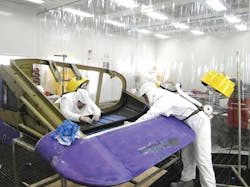MRO Operations: Composite Repair at FedEx Express
We regularly hear the predictions of continual growth in the use of advanced composites in aircraft manufacturing. However, the use of bonding as a method of fastening is not new to aviation. Decades ago nonstructural components such as fairings, closure panels, and floor boards were fabricated using fiberglass materials, aluminum skins with balsa wood core, and in some cases flight controls on airliners were fabricated using aluminum skins with aluminum honeycomb core bonded together. Eventually bonding would include advanced composite materials such as carbon graphite, synthetic aramid fibers, and hybrid fabrics, becoming more the norm for flight controls, engine nacelle systems, primary structure, and recently complete fuselages being fabricated using carbon graphite material.
Repair and overhaul of aircraft components using metal bond, fiberglass, and advanced composite materials requires facilities with specialized equipment and a well-trained staff. Airline shops, maintenance repair and overhaul (MRO) organizations, and their associated maintenance technicians these days need to be equipped and trained to accomplish these sometimes complex repairs.
Modern maintenance shops specializing in bonded repairs require purpose-built facilities having dust collection equipment, environmentally controlled rooms for layup, temperature- controlled storage units for material and adhesive storage, safety features for the skilled people doing the work, and all the specialized tooling and equipment necessary when repairing bonded components. No longer does the far corner of the hangar or remote shop location suffice for this sometimes dust generating preparation and highly sensitive processes.
The new shop at LAX
I had the opportunity to visit the recently completed composite repair shop at FedEx Express Air Operation’s maintenance facility at Los Angeles International Airport (LAX). The LAX maintenance facility has hangar capacity for two heavy maintenance lines of MD-10 and MD-11 aircraft, along with a variety of support shops; sheetmetal, welding, numerous component repair areas, and the recently completed new composite repair area.
The new composite shop is nearly 9,000 square feet, operates on two shifts with a current staff of 27 aircraft maintenance technicians (AMTs), two leads, and a manager. Additional technical support comes from the maintenance base’s inspection and structural engineering groups. Like most composite shops, this one is no different and is responsible for a variety of work from paint touchup to advanced repairs using carbon graphite material.
Hector Chavez, manager of the LAX composite shop, says, “Currently we accomplish fiberglass and carbon graphite wet layup repairs, pre-impregnated (pre-preg) material hot-bond repairs, metal-bond repairs, and painting. We support the two heavy-check lines here at LAX for removed components and on-wing repair work, line maintenance support here at LAX, and we provide emergency support for the entire system when needed. We do it all from simple paint touchup, to on-wing repairs, to complex bonded repairs only capable in the shop.”
When developing the new composite shop Chavez says, “The footprint of this shop is very similar to the FedEx Express composite shops in Memphis (MEM) and Indianapolis (IND). We have an environmentally controlled area for sanding and grinding, and a separate environmentally controlled “clean-room” for layup and curing of repairs.”
The dedicated sanding room has downdraft airflow into the grated floor for collection of the dust and debris from sanding and grinding. But personnel safety begins well before you enter this area. Prior to entering the sanding room you first come through the Doff room which contains all of the personal protective equipment (PPE) necessary for working in this area. Once suited-up the technicians pass through the “air shower,” a self-contained chamber that as the name implies, showers you with air blowing containments off your clothing and into a filtration system. You must pass through the air chamber both entering and exiting the sanding room.
During my visit to the shop one of the large components being repaired was an MD-11 tail cone assembly. The tail cone is the closure for the aircraft’s auxiliary power unit (APU) and is located below the number two engine on the MD-11. After years of service the carbon graphite skins become damaged, the internal stiffeners and frames become cracked, and due to its location oil becomes ingested into the composite materials, creating additional challenges when repairing this unit.
The tail cone was completely disassembled in order to make the necessary repairs and to replace the inner skin stiffeners. Cracked inner skin stiffeners are carefully removed as to not damage the graphite skin. Layers of carbon graphite pre-preg material are laid-up on a bond mold the shape of the stiffener and heat cured. After trimming the replacement stiffeners to size they were bonded in place on the inner skin of the tail cone.
When asked what the most complicated repair the shop accomplishes, the answer wasn’t a carbon graphite component but the trapezoid panels on the MD-10 and MD-11 aircraft. The trap-panels as they are referred to are fastened to the aircraft on the upper surface of the wings near the wing root area. They are made using thin aluminum skins, aluminum doublers and frame, and fiberglass honeycomb core. The panels have compound contours with various angles and shapes. Water ingestion eventually causes corrosion of the internal bond-lines and delamination occurs.
Generally, all new skins and doublers are fabricated and the original framework which contains the contours and curves is reused. All these detailed parts are carefully cleaned, etched, bond primer is applied, and assembled with film adhesive onto the bond mold or fixture to hold the shape. These particular panels are then vacuum-bagged, the vacuum bag being the clamp affect, and the adhesive is cured using a specific time and temperature curing profile. Once cured, the panels require a fair amount of cleanup, sanding, grinding, fitting, and eventually reinstalled on the aircraft and painted.
Training
Chavez explains the training program for new entrants into the composite shop. “We have a program of both on-the-job training (OJT), computer-based training, and classroom training. This includes being paired with a mentor. When someone new comes into the composite shop they first begin with paint. Everyone learns to paint. Part of this training is detecting the different types of paint used, what is normal paint wear and tear versus poor adhesion or paint quality problems. This also includes paint mixing and preparation, use of fillers, sandin, and paint removing – the entire paint process.”
Next, new AMTs learn standard fiberglass repair using both wet-layup and eventually heat cured pre-impregnated materials. Then they move on to learn metal-to-metal bonded repairs, followed by metal-to-fiberglass bonding. Finally, after successfully making their way through these processes, they will learn advanced composite repairs using materials such as carbon graphite. During this time they learn how to use hot-bond control consoles, heat blanket selection and use, vacuum bagging techniques, and much more.
The entire OJT program for the composite shop takes nine to 10 months. Part of the monthly crew meeting agenda in the composite shop is “lessons learned.” Discussions take place using maintenance manuals, photos, and other job-aids in an effort to mistake-proof repair processes and learn from errors.
FedEx core philosophy
When it comes to hiring technicians FedEx is very selective about hiring the best people. Steve Sobczak manages the composite, sheetmetal, welding, and tooling support shops at LAX. As an example, Sobczak explains they recently had openings for five sheetmetal technicians at the LAX location. Sobczak says, “So far we have 125 resumes, we will select 15 to interview, and hire five. And hiring the best people goes way beyond a candidate having great technical skills alone.”
With all of the options available these days for having specialized repair shops accomplish this type of work, I asked the question why continue to develop and invest in the new composite shop instead of outsourcing to one of the many specialized repair stations authorized and capable of this type of work.
Sobczak explains, “It starts with the FedEx core philosophy: People-Service-Profit. We feel we have the best people in the industry, and that no one can do it better.” Sobczak went on to say, “We and our customers are better served doing as much as we can with our own people, and this is yet another way of taking care of our people by helping create job security with FedEx. We believe when we take care of our people, our people take care of our service and this takes care of FedEx (profit).
It became very clear how FedEx feels about their people. In fact LAX was one of three FedEx teams participating in the recent AMTSociety Maintenance Skills Competition. Chavez reminded me the vice president of maintenance from Memphis was one of the senior leadership staff that spent the entire time at the MSC, strongly supporting this type of participation and celebration. Given the tough times the airline industry AMTs have seen in recent years, it was refreshing to hear the focus on this company’s AMTs, and the explanation of the FedEx core philosophy of People-Service-Profit.

